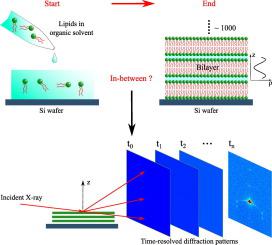Biochimica et Biophysica Acta (BBA) - Biomembranes ( IF 3.4 ) Pub Date : 2020-08-09 , DOI: 10.1016/j.bbamem.2020.183437 Yihui Xu 1 , Huaidong Jiang 1

|
Supported lipid multi-bilayers or bilayer stacks are an important model membrane system, particularly suitable for surface-sensitive characterization methods like X-ray and neutron diffraction. Spreading organic solution (sOS) is one of the most widely used protocols for the preparation of lipid multi-bilayers. Despite its great popularity, the self-assembly mechanism of the bilayers is not yet fully elucidated, limiting further improvements of this protocol.
In order to solve this problem, we investigated the formation process of lipid bilayers in the sOS protocol, using in-situ time-resolved X-ray diffraction, complemented by X-ray reflectivity and molecular dynamics simulation. Results reveal a simultaneous self-assembly scheme for both cholesterol-free and cholesterol-containing bilayers, with one bilayer phase forming at the surface and the other forming in the solution. The solution phase gradually transforms into the surface phase, yielding clean single phase in the end.
中文翻译:

通过时间分辨X射线衍射研究了支持脂质多层的自组装。
支持的脂质多层或双层堆叠是重要的模型膜系统,特别适用于表面敏感的表征方法,例如X射线和中子衍射。分散有机溶液(sOS)是制备脂质双层的最广泛使用的方案之一。尽管它很受欢迎,但双层的自组装机制尚未完全阐明,限制了该协议的进一步改进。
为了解决这个问题,我们使用原位时间分辨X射线衍射,X射线反射率和分子动力学模拟,研究了sOS方案中脂质双层的形成过程。结果揭示了无胆固醇和含胆固醇双层的同时自组装方案,其中一个双层相形成于表面,另一层形成于溶液中。溶液相逐渐转变为表面相,最终产生干净的单相。



























 京公网安备 11010802027423号
京公网安备 11010802027423号